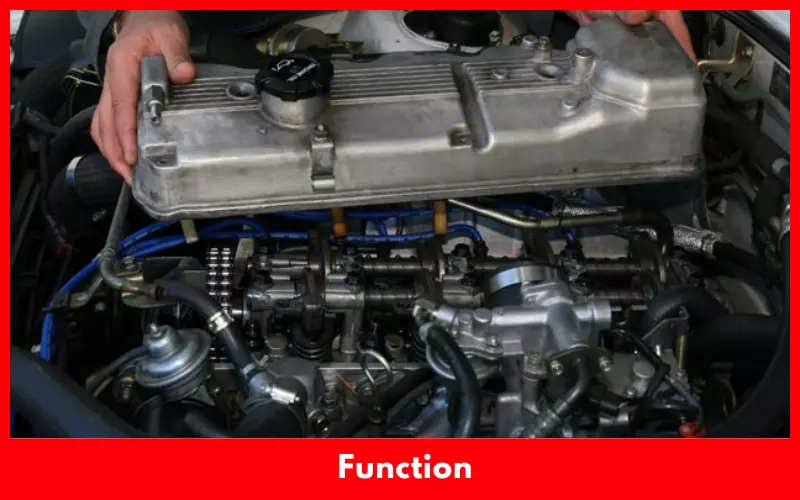Head gasket and valve cover gasket may seem quite the same, but they have a huge difference in terms of placement, functions, design, and maintenance cost.
Choosing between head gasket vs valve cover gasket guide, we’ll deeply explore their key differences.
In comparison, the Head gasket is made of metal and sealed between the engine block and cylinder head. It withstands extreme heat and costs thousands to replace. The valve cover gasket is placed on the top of the cylinder head. It’s made of rubber or fiber and is used to prevent oil leaking. Let’s get the details
Article Summary
Key Differences Between Head Gasket Vs Valve Cover Gasket
The key difference between head gasket and valve cover gasket is that the head gasket separates coolant and oil passages while the valve cover gasket prevents oil leaks. Other differences are:
1. Placement
A valve cover gasket is placed on top of the cylinder head on the engine’s top. It seals the valve cover with the engine. This thin gasket also runs around the underside’s outer edge of the valve cover.

The head gasket is placed between the engine block and cylinder head. So, you’ll need to disassemble the engine’s entire top end to get access to the head gasket. This flat gasket covers the engine block’s top with various coolant and oil channels and cylinder cutouts.
2. Function
The valve cover gaskets prevent oil from leaking from the valve cover to the head gaskets. This part of the engine determines engine compression and prevents coolant from leaking into the oil pan. It also protects oil from seeping out of the covers and sees some pressure. It keeps contaminants out of the engine.

The head gasket protects engine compression from blowing out. These stronger seals also endure fuel combustion pressure and seal the combustion chamber. The head gasket deals with a corrosive environment that the combustion makes. Another job of the head gasket is to seal the cooling system ports that run from the block to the head.
3. Effects of Failure Parts
If the head gasket fails, your car engine will lose compression in the cylinders and may cause a misfire. It can also make an ingress point for coolant to enter into the crankcase and engine oil can mix with coolant. It can also cause hydrostatic locks and looms.

The head gasket needs to withstand extensive pressure of internal combustion without leaking fuel, oil, coolant, or gases. So if the head gasket fails, your vehicle’s engine will lose power, compression, and durability.
If the valve cover gasket fails, your car engine will leak and cause a fire if hot oil makes contact with hot exhaust components. A damaged valve cover gasket can also make an ingress point for water and other contaminants.
4. Material
The valve cover gasket is made of cork, soft rubber, or fiber to seal against oil leaks. It can’t hold up under torque. A head gasket needs to withstand high pressure and heat. So it’s made of a combination of asbestos fabric and steel. The head gasket is thicker, more heat resistant, and durable than the valve cover gasket. It can also hold up under high torque values.
Causes of Valve Cover Gasket And Head Gasket Leak
The valve cover gasket can leak due to plenty of reasons including worn-out casing, and shrunken micro-tear. Loose valve bolts can also make the valve cover gasket leak.
The symptoms of leak valve cover gaskets are stains and soiling, engine overheating, burning smell, and low engine oil levels.
The head gasket can blow out or leak due to an overheated engine, expanded engine block, and cylinder head. Detonation can also cause head gasket failure as it damages the fire ring and allows the leak to pass the armours. The symptoms of a blown head gasket are white smoke coming from the tailpipe, overheating the engine, rough idle, low coolant level, and contaminated oil.
Replacement Cost
valve cover gasket replacement cost varies depending on the car’s make and model. The cost of the valve cover gasket is around $10 and $40 and the labor can charge between $110 and $340 for replacing the job.

Replacing the head gasket is more expensive than the valve cover gasket due to its complex design. It can cost around $1000 to $3000 to replace the head gasket including labor charges.
Longevity
The head gasket lasts around 200,000 miles on average. On the other hand, the valve cover gasket lasts around 20,000 to 50,0000 miles. However, you can prolong these component’s lifespan by following some tips.
To increase the longevity of the head gasket, regularly inspect the cooling system. Use high-quality and the right type of coolant to maintain the ideal temperature and protect the head gasket from damage. Maintaining the correct mixing ratio is also important.
To increase the valve cover gasket’s lifespan, use a high-quality filter and oil. Inspect the valve cover gasket periodically for oil leaks, cracking, or wear. You can also use gasket sealant to increase the gasket longevity.
Can You Drive With A Leak Valve Cover Gasket?
If the valve cover gasket leaks, fix it immediately before it turns into an expensive repair. However, you can continue driving for a while with a leak valve cover gasket. There is plenty of risk of driving with a leak valve cover gasket. If the oil drips from the valve cover leaks on the exhaust, it’ll stink and can cause fire risk.

If the oil drips around the spark plug and coil packs, it can cause misfiring. Another possibility is that if the oil enters the engine’s mounts rubber bushes or hoses, it can make them sponge. So you may need to replace these parts.
Can You Drive With A Leak Head Gasket?
If the head gasket leaks, it can cause the engine to overheat and damage the engine severely. Though you shouldn’t continue driving with a leak head gasket, you can do so after following some tricks.
Monitor the engine temperature gauge during driving with the leak head gasket. If the temperature starts climbing into the red zone, stop driving and wait until the engine cools down. Don’t drive with an overheated engine.
Don’t use excessive throttle when driving with a leak head gasket. If you need to accelerate, apply it slowly. If you accelerate suddenly, it can put extra stress on the damaged head gasket and fail it completely.
You shouldn’t drive too long with a leaking gasket, especially at a time. Instead, drive for short distances and apply breaks frequently.
How To Troubleshoot Valve Gasket and Head Gasket Leaks?
You can determine the head gasket’s leak in plenty of ways including applying compression test and dye test. In the dye test, you’ll need to mix special dye and coolant then apply it to the potential area. Then you need to apply a blacklight to find the leak in the head gasket.
To find the leak in the valve cover gasket, check the oil level using a dipstick. If the oil level is low, look for the leak. Another sign of a valve cover gasket leak is oil around the spark plugs.
FAQs
Is Valve Cover Gasket Same As Rocker Cover Gasket?
A valve cover gasket is known as a rocker cover gasket. It’s made of plastic or rubber and makes a tight seal between the engine and its rocker cover. It helps the car run smoothly.
Is It Worth Fixing A Head Gasket?
The head gasket is quite expensive part and it can take thousands to replace the head gasket. Though it may take hours and tiresome effort to repair the head gasket, most mechanics recommend repairing it.
Is Cylinder Head Cover Same As Valve Cover?
Both cylinder head cover and valve covers are the same terms and are used interchangeably in the automotive industry. It is referred to as a valve cover as it seals the valves. It is also called a cylinder head cover as it seals the cylinder head.
Final Words
After knowing the differences between head gasket vs valve cover gasket guide, hope you understand their key differences. Now you should be able to set both the head gasket and valve cover gasket apart and use them according to their designed intent.
Both the head gasket and valve cover gasket are vital components under the hood. So having clear knowledge about the head gasket and valve cover gasket’s functions, causes and symptoms of leaking can help you maintain them properly.

